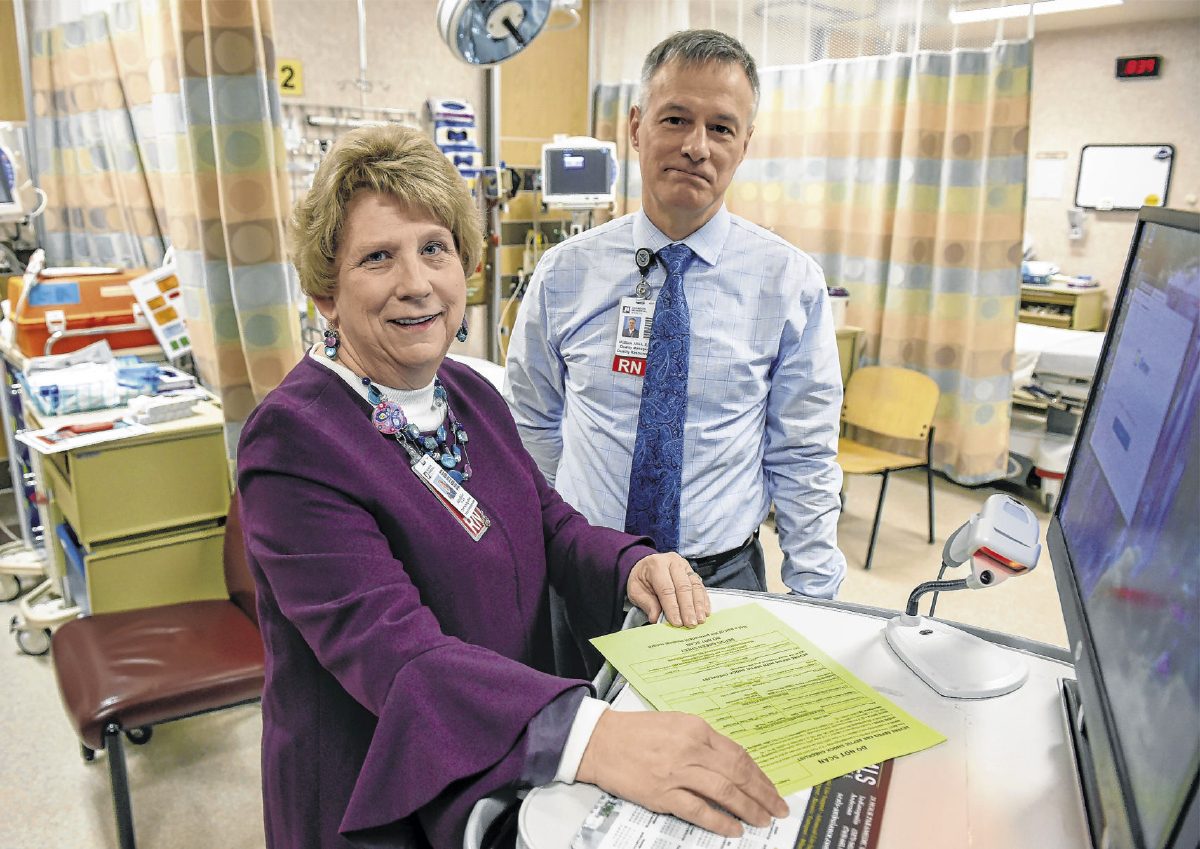Even in the middle of recovery, something was still wrong.
Anita Keller, chief nursing officer at Johnson Memorial Health, had a spinal fusion about five years ago. As she was healing from her surgery, she felt increasingly ill and run down.
A urinary tract infection developed that she thought she could treat on her own. At the same time, a cyst on her kidney ruptured. All of these conditions together added immense strain to her body, and as a result, she developed sepsis.
[sc:text-divider text-divider-title=”Story continues below gallery” ]
Keller survived after a hospital stay that included large doses of antibiotics, but about 8 million people annually die from sepsis, according to Sepsis Alliance, a nonprofit organization that brings awareness and raises money to help support survivors.
“I was one of the lucky ones,” she said.
Her experience has driven efforts to better diagnose and treat sepsis. Over the last few years, Keller has helped spearhead a committee developing internal policies for medical professionals at Johnson Memorial Health, as well as educational policies for the community.
Those efforts have made the Franklin hospital one of the best in the state and nation at recognizing and treating patients with sepsis.
Johnson Memorial Health is in the top 20 percent at hitting sepsis recognition and treatment measures, according to metrics from the Centers for Medicare and Medicaid Services. The hospital’s average score is one of the best in the state.
This year, Johnson Memorial Health is expected to treat 320 patients for sepsis in 2019. Their success at treating the patients is due to every medical professional at the hospital working together to recognize and treat it, Keller said.
Every person who might treat a patient at Johnson Memorial Health, including doctors, nurses, respiratory therapists and pharmacists, are trained to look for common symptoms of the infection, she said.
“We have a total commitment from all employees and providers who touch that patient,” Keller said.
Sepsis starts as an infection in the body. When a person gets an infection, white blood cells are sent to the infection site to clear up the infection. With sepsis, something goes wrong and the white blood cells begin attacking the body, medical professionals at Johnson Memorial Health said.
Some people survive, but once sepsis sets in, doctors are working to try and save the organs, said Brett McCullough, director of medicine at Johnson Memorial Health.
“Literally anything can happen with sepsis,” McCullough said. “We are trying to protect the heart, the kidney, the liver, the brain.”
A few years ago, hospital officials began to revamp their internal policies regarding sepsis diagnoses and care in anticipation of meeting rubrics from the Centers for Medicare and Medicaid Services, Keller said.
Officials at the Centers for Medicare and Medicaid Services began analyzing data that said that sepsis had a high mortality and hospital readmission rate nationally, she said.
The Centers for Medicare and Medicaid Services set forth a 15-point data rubric that medical professionals must hit in order to be in compliance. The standards outline when tests that help diagnose sepsis must be done, and when some of the treatments must start. One missed measure means the standard was failed, Keller said.
Johnson Memorial Health officials anticipated the standards and started a committee with about 15 people who would develop practices as well as rules hospital and campus officials must follow to make sure they are hitting the standard every time, said Dr. Ryan White, Johnson Memorial Health’s emergency services director.
Committee members met for a year to develop plans on how they would hit every measure set forth by the Centers for Medicare and Medicaid Services.
“We realized we had to have a solid plan in place, something that was foolproof, and that we didn’t miss any measures,” White said.
In some cases, Johnson Memorial Health officials thought they could do even better. For example, in certain cases, internal hospital polices call for testing and treatment faster than what is laid out in the Centers for Medicare and Medicaid Services measures, White said.{span id=”docs-internal-guid-3611b9aa-7fff-6ff1-b03a-459ac35744bb” style=”font-size: 11pt; font-family: Arial; color: #000000; background-color: transparent; font-weight: bold; font-style: normal; font-variant: normal; text-decoration: none; vertical-align: baseline; white-space: pre-wrap;”}{/span}
Before the measures started, the hospital had compliance rates in the mid-60 percents, with other hospitals in the low-30 percents. Now, Johnson Memorial Hospital has routinely hit compliance rates in the mid-90 percents, White said.
Every medical professional in the hospital is well versed in the guidelines, which is the biggest part of the success of the program, McCullough said.
“We all stress it within our departments, and really, the collaboration is what is key and it is what we do better than most other hospitals in Indiana and probably the United States, “ McCullough said.
Their success at treating sepsis is also part of the reason Johnson Memorial Hospital was recently graded an “A” by LeapFrog, a nonprofit organization that advocates for hospital transparency. Hospitals are graded on 27 measures, including bed sore rate, rate of items left in patients after surgery and communication of doctors to patients about prescriptions and hospital discharge instructions.
[sc:pullout-title pullout-title=”By the numbers” ][sc:pullout-text-begin]
320: Estimated number of sepsis patients Johnson Memorial Health will treat in 2019.
15: Number of steps Johnson Memorial Health professionals follow when diagnosing and treating sepsis.
[sc:pullout-text-end][sc:pullout-title pullout-title=”At a glance” ][sc:pullout-text-begin]
Here are some symptoms of sepsis:
- An elevated or lowered body temperature
- Symptoms of an infection, which could include fatigue and pain
- Mental decline, such as confusion and sleepiness
- Incredible illness, patients can feel the worst they ever have
Source: Sepsis Alliance
[sc:pullout-text-end]





